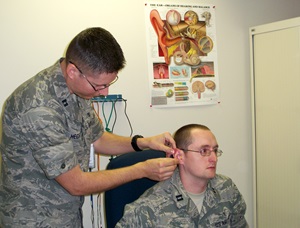Types of Hearing Aids
 Hearing aids can be categorized or grouped according to the following styles:
Hearing aids can be categorized or grouped according to the following styles:
Behind-the-Ear or BTE
Behind-the-ear hearing aids are the most powerful, reliable, and durable. The devices come in mini or standard BTE options. BTEs rest on the back of the ear, and are connected to the ear canal via a tube that is part of an ear mold, which is custom made from an impression of your ear. BTEs have all the electronic components behind the ear, which makes them less susceptible to damage from earwax and moisture. Individuals with mild-to-severe hearing loss can be fit with BTE hearing aids.
Open-Fit Behind-the-Ear
Open-fit behind-the-ear hearing aids are reliable. These devices are available in mini or standard BTE options. Open-fit BTEs rest on the back of your ear, and are connected to the ear canal via a thin tube. There is no custom piece that fits into the ear canal. Because the ear canal is not occluded, the wearer is able to utilize more of their own natural hearing, which results in a more natural and improved sound quality. Open-fit BTEs have all the components behind the ear, which makes them less susceptible to damage from earwax and moisture. This is one of the most cosmetically appealing hearing aids. These devices are appropriate for people with normal-to-near-normal hearing in the low pitches, and mild-to-moderately severe hearing loss in the high pitches.
Receiver-in-Canal or RIC
Receiver-in-canal hearing aids come in a standard or mini BTE option. These devices rest atop or on the back of the ear and a thin-coated wire leads down to the receiver. The receiver is covered by a non-custom dome or custom ear mold and sits inside the ear canal. Positioning the receiver inside the ear canal allows people with more severe hearing loss to wear a more cosmetically appealing device. RIC hearing aids also reduce feedback, and when configured as an open fit instrument, afford improved sound quality, resulting from the lack of ear canal occlusion. These instruments are appropriate for people with mild-to-severe hearing loss.
In-the-Ear or ITE
In-the-ear units are the most powerful, custom-made style and fit completely in the outer ear. For most patients, these devices are easy to operate. ITEs can be used by people who have mild-to-severe hearing loss.
In-the-Canal or ITC
In-the-canal units fit in the ear canal. These aids are similar to ITE aids, but they are smaller and may require better dexterity for insertion and removal, battery replacement, and volume adjustments. ITCs are appropriate if you have mild-to-moderately severe hearing loss.
Completely-In-Canal or CIC
Completely-in-canal units are the smallest hearing aids. They require a removal string due to their small size because they fit so deeply into the ear canal. Some features, such as multiple microphones for directional listening in noisy environments, are not available on these instruments because of size limitations. The battery life for this style is short because the battery is so small. CICs are most appropriate for individuals with mild-to-moderate hearing loss.